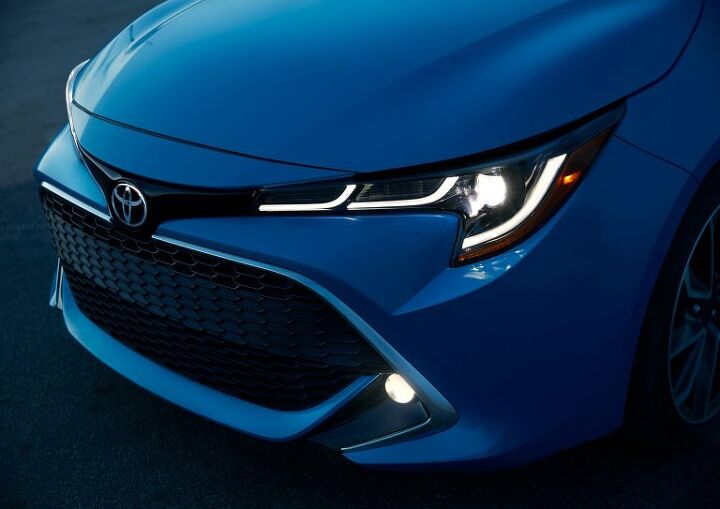Toyota Pauses Production at 9 Plants Following Weekend Earthquake

Japan was struck by a 7.1 magnitude earthquake over the weekend. The Fukushima and Miyagi prefectures were hit the hardest, offering a physical reminder of the 9.0 magnitude quake that devastated the region in 2011. Scientists have claimed that Saturday’s tremor was actually an aftershock from the horror show that occurred a decade earlier.
While still a large systemic event, authorities aren’t reporting widespread injuries or even damages. However, many citizens were left without power and numerous industrial facilities were idled for inspection. This includes automakers, with Toyota making an announcement that it will be stalling nine factories for several days this week. Though only some of that time is needed for safety assessments. The automaker is fretting over a batch of suppliers that were impacted by the quake and is anticipating a parts shortage.
Models most likely to be affected are the domestically manufactured Toyota C-HR and highly popular RAV4. Lexus models will also see diminished output across the board. Toyota has not yet issued any projections for unit losses, though they’re likely to be substantial when added to production delays caused by the semiconductor shortage. Lines are expected to resume operations starting on February 20th, supply chain permitting.
[Image: Toyota]

A staunch consumer advocate tracking industry trends and regulation. Before joining TTAC, Matt spent a decade working for marketing and research firms based in NYC. Clients included several of the world’s largest automakers, global tire brands, and aftermarket part suppliers. Dissatisfied with the corporate world and resentful of having to wear suits everyday, he pivoted to writing about cars. Since then, that man has become an ardent supporter of the right-to-repair movement, been interviewed on the auto industry by national radio broadcasts, driven more rental cars than anyone ever should, participated in amateur rallying events, and received the requisite minimum training as sanctioned by the SCCA. Handy with a wrench, Matt grew up surrounded by Detroit auto workers and managed to get a pizza delivery job before he was legally eligible. He later found himself driving box trucks through Manhattan, guaranteeing future sympathy for actual truckers. He continues to conduct research pertaining to the automotive sector as an independent contractor and has since moved back to his native Michigan, closer to where the cars are born. A contrarian, Matt claims to prefer understeer — stating that front and all-wheel drive vehicles cater best to his driving style.
More by Matt Posky
Latest Car Reviews
Read moreLatest Product Reviews
Read moreRecent Comments
- TheEndlessEnigma I would mandate the elimination of all autonomous driving tech in automobiles. And specifically for GM....sorry....gm....I would mandate On Star be offered as an option only.Not quite the question you asked but.....you asked.
- MaintenanceCosts There's not a lot of meat to this (or to an argument in the opposite direction) without some data comparing the respective frequency of "good" activations that prevent a collision and false alarms. The studies I see show between 25% and 40% reduction in rear-end crashes where AEB is installed, so we have one side of that equation, but there doesn't seem to be much if any data out there on the frequency of false activations, especially false activations that cause a collision.
- Zerocred Automatic emergency braking scared the hell out of me. I was coming up on a line of stopped cars that the Jeep (Grand Cherokee) thought was too fast and it blared out an incredibly loud warbling sound while applying the brakes. I had the car under control and wasn’t in danger of hitting anything. It was one of those ‘wtf just happened’ moments.I like adaptive cruise control, the backup camera and the warning about approaching emergency vehicles. I’m ambivalent about rear cross traffic alert and all the different tones if it thinks I’m too close to anything. I turned off lane keep assist, auto start-stop, emergency backup stop. The Jeep also has automatic parking (parallel and back in), which I’ve never used.
- MaintenanceCosts Mandatory speed limiters.Flame away - I'm well aware this is the most unpopular opinion on the internet - but the overwhelming majority of the driving population has not proven itself even close to capable of managing unlimited vehicles, and it's time to start dealing with it.Three important mitigations have to be in place:(1) They give 10 mph grace on non-limited-access roads and 15-20 on limited-access roads. The goal is not exact compliance but stopping extreme speeding.(2) They work entirely locally, except for downloading speed limit data for large map segments (too large to identify with any precision where the driver is). Neither location nor speed data is ever uploaded.(3) They don't enforce on private property, only on public roadways. Race your track cars to your heart's content.
- GIJOOOE Anyone who thinks that sleazbag used car dealers no longer exist in America has obviously never been in the military. Doesn’t matter what branch nor assigned duty station, just drive within a few miles of a military base and you’ll see more sleazbags selling used cars than you can imagine. So glad I never fell for their scams, but there are literally tens of thousands of soldiers/sailors/Marines/airmen who have been sold a pos car on a 25% interest rate.


































Comments
Join the conversation
Japan's tectonic woes are like a James Bond martini...shaken not stirred.
Natural disasters come in all sizes. If you are like me and your gutters are currently full of ice and your roof is full of snow, and you live in a place where this doesn't normally occur [and therefore your home has no ice dam membrane at the eaves], now is the time to do a little research and save yourself some heartache: https://extension.umn.edu/protecting-home-rain-and-ice/dealing-and-preventing-ice-dams https://www.jlconline.com/how-to/roofing/ice-dam-membrane-at-eaves_o Ice dams: You can learn about them now or you can learn about them later. (How much do you enjoy drywall work?)